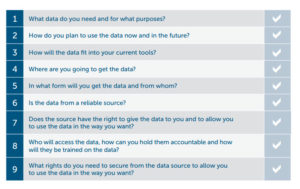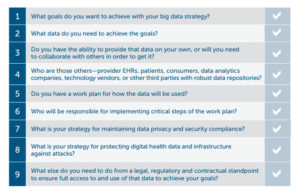The interest in leveraging the value of big data in digital health has become a focus of health care industry mainstays and newcomers alike. Within a challenging regulatory landscape, it is critical for those looking to play in this space to be proactive in planning their data strategy, with an eye towards compliance planning and solid due diligence to maximize its value. In this Q&A, big data thought leaders Bernadette Broccolo and Sarah Hogan, both partners in McDermott Will & Emery’s Health Industry Advisory group, discuss the challenges and opportunities that health industry stakeholders face when stepping into the world of big data.
For information on this topic and to hear the full Q&A with Bernadette and Sarah, listen to the newest episode of the Of Digital Interest podcast. You can access the full episode at here or subscribe to the podcast on iTunes, Pocket Casts or Soundcloud.
Q. Where is the value in big data in digital health? Who is seeing value today and what are their motivations?
BB: The best short answer is that everybody is seeing value – both long standing industry players and newcomers. The real value in big data comes not from raw data or just having a lot of data, but in the ability to use it and mine it, to have it in a form that’s analyzable. What’s very surprising too, in addition to the speed with which the interest in big data has escalated, is who is interested. In the past, one certainly expected academic medical centers and universities that have major research initiatives and clinical trial initiatives to be interested. But now others like molecular lab testing organizations, CLIA regulated laboratories and entrepreneurs are interested in capturing data.
SH: I think one of the surprising players is actually the pharma companies. It may sound odd to say that, but they have a lot of data – including a lot of clinical data – that they’re looking at mining to determine how they can target their therapeutics in a way that helps patients more efficiently. They are looking at themselves and asking “What does the 21st century pharma company look like?”
Q. When you think about these newcomers how do they have to think differently or plan differently around the use of big data?
BB: Any of the stakeholders involved, whether they’re doing something on their own or in collaboration with others, will be facing many more legal issues than they are used to. There are many issues. They are complex. They are not harmonized. They exist at the federal level and at the state level and they are continuing to evolve. It’s not just about considering the issues that you are used to addressing, but also recognizing there are others, and that they must be dealt with on the front-end when these opportunities arise.
Q. Are these issues barriers, and how do stakeholders approach them so as not to curtail their ability to play in the big data area?
SH: We need to think about the regulatory scheme as creating challenges and not obstacles. Our clients need to think about their data strategy and look at it as a whole compliance approach. They can have a substantially compliant strategy—and once they get that into place, they need to make sure they come back and revisit it regularly. As the regulatory landscape and the client’s data strategy evolves over time it requires revisiting and making sure that the data remains available and that the integrity of the data is maintained.
Q. Beyond the regulatory landscape, what other challenges should companies be thinking about proactively planning for as they look to navigate their path forward in the digital health space around data?
BB: One of the very first steps that a stakeholder who is reliant on big data—either as a strategy or a key tool for their strategy—needs to take is data mapping. There are a lot of legal and regulatory issues that can be better addressed if you do that data mapping upfront. If you skip the data mapping you may hit some roadblocks and your initial effort may fail or the opportunities to supercharge your initial effort and leverage it into some other opportunity may be more limited than you would have liked.
SH: The challenge in the background here is that the data is in these disparate systems. Doing the data mapping that Bernadette was talking about is really crucial so that you can figure out who the right partners are to get the solutions that you want. You don’t want to be in a position where you’ve developed an algorithm and you spent millions of dollars and a long period of time to create it, and then it all falls apart because you didn’t have the right to use that data.
Q: What is the one thing that you would want for people to take away from this as they are launching a new big data or digital health initiative?
BB: The point that I make every time I am asked to address issues in this area is: fight the urge to either ignore or delay addressing the myriad issues that really are key to having the infrastructure for a solid successful and sustainable initiative. There are a lot of reasons why there will be that urge and it will be difficult to fight. The key takeaway is plan, plan, plan and solid due diligence.
Download The Law of Digital Health Executive Summary to find out more.




